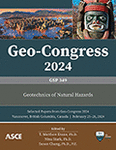Sliding Mass Period for Seismic Displacements of Spatially Variable Slopes
Publication: Geo-Congress 2024
ABSTRACT
Deterministic and probabilistic procedures for estimating seismic displacements of engineered and natural slopes depend on the uncertainty of the seismic yield coefficient (ky) and the initial fundamental period (Ts) of the potential sliding mass. However, inherent soil spatial variability within slopes can significantly contribute to the uncertainty in the potential sliding mass extent, which propagates to uncertainties in ky and Ts. This study investigates the influence of subsurface soil variability, as modeled by non-stationary spatial random fields of the undrained shear strength, on the resulting variability of ky and Ts for a hypothetical slope geometry. The random fields assume a lognormal distribution, with alternative assumptions for the mean, coefficient of variation, and horizontal correlation range. Pseudostatic stability analyses for determining ky and the associated sliding mass geometry were performed using the finite difference program FLAC. The Ts was evaluated using a mass-weighting scheme and considered the influence of alternative soil shear wave velocity assumptions. The results demonstrate important considerations for interpreting the variability of ky and Ts for deterministic and performance-based seismic displacement studies.
Get full access to this article
View all available purchase options and get full access to this chapter.
REFERENCES
Bassal, P. C., Boulanger, R. W., and DeJong, J. T. 2022. “System Response of an Interlayered Deposit with Spatially Distributed Ground Deformations in the Chi-Chi Earthquake.” Journal of Geotechnical and Geoenvironmental Engineering. ASCE, 148(10). https://doi.org/10.1061/(ASCE)GT.1943-5606.0002869.
Bray, J. D., and Travasarou, T. 2007. “Simplified procedure for estimating earthquake-induced deviatoric slope displacements.” Journal of Geotechnical and Geoenvironmental Engineering, 133(4), 381–392.
Bray, J. D., and Macedo, J. 2019. “Procedure for estimating shear-induced seismic slope displacement for shallow crustal earthquakes.” Journal of Geotechnical and Geoenvironmental Engineering. 145 (12): 04019106. https://doi.org/10.1061/(ASCE)GT.1943-5606.0002143.
Bray, J. D., and Macedo, J. 2021. “Closure to ‘Procedure for Estimating Shear-Induced Seismic Slope Displacement for Shallow Crustal Earthquakes.” Journal of Geotechnical and Geoenvironmental Engineering, ASCE, https://doi.org/10.1061/(ASCE)GT.1943-5606.0002143.
Bray, J. D., and Macedo, J. 2023. “Performance-based seismic assessment of slope systems.” Soil Dynamics & Earthquake Engineering, 168 (107835). https://doi.org/10.1016/j.soildyn.2023.107835.
Duncan, J. M. 2000. “Factors of safety and reliability in geotechnical engineering.” Journal of Geotechnical and Geoenvironmental Engineering. 126(4), 307–316.
El Kateb, T., Chalaturnyk, R., and Robertson, P. K. 2003. “An overview of soil heterogeneity: Quantification and implications on geotechnical field problems.” Canadian Geotechnical Journal. 40(1): 1–15. https://doi.org/10.1139/t02-090.
El-Ramly, H., Morgenstern, N. R., and Cruden, D. M. 2002. “Probabilistic slope stability analysis for practice.” Canadian Geotechnical Journal. 39 (3), 665–683.
Griffiths, D. V., and Fenton, G. A. 2000. “Influence of soil strength spatial variability on the stability of an undrained clay slope by finite elements,” in Slope Stability 2000, Geotechnical Special Publication No. 101, American Society of Civil Engineering, New York, pp. 184–193.
Griffiths, D. V., Huang, J., and Fenton, G. A. 2015. “Probabilistic slope stability analysis using RFEM with non-stationary random fields.” In: Schweckendiek, T., van Tol, A. F., Pereboom, D., et al. (Eds.), Geotechnical Safety and Risk V, pp. 704–709.
Griffiths, D. V., Huang, J., and Fenton, G. A. 2009. “Influence of spatial variability on slope reliability using 2-D random fields.” Journal of Geotechnical and Geoenvironmental Engineering, 135(10), 1367–1378.
Griffiths, D. V., and Lane, P. A. 1999. “Slope stability analysis by finite elements.” Geotechnique, 49(3), 387–403.
Heße, F., Prykhodko, V., Schlüter, S., and Attinger, S. 2014. “Generating random fields with a truncated power-law variogram: A comparison of several numerical methods.” Environmental Modelling & Software, 55, 32–48. https://doi.org/10.1016/j.envsoft.2014.01.013
Itasca. 2019. FLAC, Fast Lagrangian Analysis of Continua, User’s Guide, Version 8.1. Itasca Consulting Group, Inc., Minneapolis, MN.
Jiang, S., and Huang, J. 2018. “Modeling of non-stationary random field of undrained shear strength of soil for slope reliability analysis.” Soils and Foundations. 58 (1): 185–198. https://doi.org/10.1016/j.sandf.2017.11.006.
Macedo J., Bray, J. D., Abrahamson, N., and Travasarou, T. 2018. “Performance-Based Probabilistic Seismic Slope Displacement Procedure.” Earthquake Spectra, 34(2): 673–695. DOI: 10.1193/122516EQS251M.
Makdisi, F. I., and Seed, H. B. 1978. “Simplified procedure for estimating dam and embankment earthquake-induced deformations.” Journal of the Geotechnical Engineering Division, 104(7), 849–867.
Mayne, P. W., and Rix, G. J. 1995. “Correlations Between Shear Wave Velocity and Cone Tip Resistance in Natural Clays.” Soils and Foundations. 35(2): 107–110.
Müller, S., Schüler, L., Zech, A., and Heße, F. GSTools v1.3: a toolbox for geostatistical modelling in Python, Geosci. Model Dev., 15, 3161–3182, https://doi.org/10.5194/gmd-15-3161-2022, 2022.
Newmark, N. 1965. “Effects of earthquakes on dams and embankments.” Geotechnique. 15(2): 139–160.
Phoon, K. K., and Kulhawy, F. H. 1999. “Characterization of geotechnical variability.” Canadian Geotechnical Journal. 36(4): 612–624.
Pretell, R. A., Ziotopoulou, K., and Davis, C. 2021. “Liquefaction and cyclic softening at Balboa Boulevard during the 1994 Northridge Earthquake.” Journal of Geotechnical and Geoenvironmental Engineering., ASCE, 147 (2): 05020014. https://doi.org/10.1061/(ASCE)GT.1943-5606.0002417.
Rackwitz, R. 2000. Reviewing probabilistic soil modeling. Computers and Geotechnics, 26:199–223.
Travasarou, T., Bray, J. D., and Der Kiureguian, A. 2004. “A probabilistic methodology for assessing seismic slope displacements.” Paper No. 2326, in Proceedings of the 13th World Conference on Earthquake Engineering, 1–6 August 2004, Vancouver, BC, Canada.
Yegian, M. K., Marciano, E. A., and Ghahraman, V. G. 1991. “Earthquake-induced permanent deformations: probabilistic approach.” Journal of Geotechnical Engineering 117, 35–50.
Yegian, M. K., Marciano, E. A., and Ghahraman, V. G. 1988. “Integrated Seismic Risk Analysis for Earth Dams.”, Northeastern Univ., Boston, Mass.
Information & Authors
Information
Published In
History
Published online: Feb 22, 2024
ASCE Technical Topics:
- Continuum mechanics
- Displacement (mechanics)
- Dynamics (solid mechanics)
- Earthquake engineering
- Engineering fundamentals
- Engineering mechanics
- Geohazards
- Geomechanics
- Geotechnical engineering
- Landslides
- Motion (dynamics)
- Seismic effects
- Seismic tests
- Slopes
- Soil dynamics
- Soil mechanics
- Soil properties
- Soil strength
- Solid mechanics
- Structural mechanics
- Tests (by type)
- Uncertainty principles
Authors
Metrics & Citations
Metrics
Citations
Download citation
If you have the appropriate software installed, you can download article citation data to the citation manager of your choice. Simply select your manager software from the list below and click Download.
